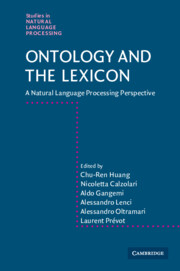Book contents
- Frontmatter
- Contents
- Contributors
- Preface
- Part I Fundamental aspects
- 1 Ontology and the lexicon: a multidisciplinary perspective
- 2 Formal ontology as interlingua: the SUMO and WordNet linking project and global WordNet
- 3 Interfacing WordNet with DOLCE: towards OntoWordNet
- 4 Reasoning over natural language text by means of FrameNet and ontologies
- 5 Synergizing ontologies and the lexicon: a roadmap
- Part II Discovery and representation of conceptual systems
- Part III Interfacing ontologies and lexical resources
- Part IV Learning and using ontological knowledge
- References
- Index
4 - Reasoning over natural language text by means of FrameNet and ontologies
from Part I - Fundamental aspects
Published online by Cambridge University Press: 06 July 2010
- Frontmatter
- Contents
- Contributors
- Preface
- Part I Fundamental aspects
- 1 Ontology and the lexicon: a multidisciplinary perspective
- 2 Formal ontology as interlingua: the SUMO and WordNet linking project and global WordNet
- 3 Interfacing WordNet with DOLCE: towards OntoWordNet
- 4 Reasoning over natural language text by means of FrameNet and ontologies
- 5 Synergizing ontologies and the lexicon: a roadmap
- Part II Discovery and representation of conceptual systems
- Part III Interfacing ontologies and lexical resources
- Part IV Learning and using ontological knowledge
- References
- Index
Summary
Introduction
Combining large lexical resources with world knowledge, via ontologies, is a crucial step for reasoning over natural language, particularly for the Semantic Web. Concrete NLP applications include semantic parsing, text summarization, translation, and question answering. For example, questions like ‘Could Y have murdered X?’ require several inference steps based on semantic facts that simple lexicons do not include. An essential ingredient is so-called openworld semantics offered by state-of-the-art Description Logic (DL) reasoners, e.g., FaCT (Horrocks, 1998) or Racer (Wessel and Möller, 2005).
The FrameNet lexicon (Ruppenhofer et al., 2006a) has a uniquely rich level of semantic detail, which is based on frame semantics (and not on open-world semantics). Therefore, we are building bindings from FrameNet to multiple ontologies. For a specific application, we choose an appropriate ontology and build the binding for this application. Thus, we enable reasoners to make inferences over natural language text.
In this chapter, we report on the first steps towards this goal: we have automatically translated a crucial portion of FrameNet to OWL DL, and we show how state-of-the-art DL reasoners can make inferences over FrameNet-annotated sentences. Thus, annotated text becomes available to the Semantic Web, and FrameNet itself can be linked to other ontologies. While our OWL translation is limited to facts included in FrameNet, links to ontologies make world knowledge available to reasoning over natural language text. Therefore, we link FrameNet to the Suggested Upper Merged Ontology (SUMO).
- Type
- Chapter
- Information
- Ontology and the LexiconA Natural Language Processing Perspective, pp. 53 - 71Publisher: Cambridge University PressPrint publication year: 2010
- 4
- Cited by



